STEM Outreach: Adopt... Adapt... Accomplish
From Rick McMaster
 Let’s talk about the three “A”s of STEM activities and the wealth of materials available. I have my favorite sources, PBSKids, Teachers TryScience, Sparticl, and, of course, MIT BLOSSOMS. If you are looking for vetted activities, head to CPALMS. You don’t have to be a Florida teacher or resident to take advantage of this great toolbox. Let’s talk about the three “A”s of STEM activities and the wealth of materials available. I have my favorite sources, PBSKids, Teachers TryScience, Sparticl, and, of course, MIT BLOSSOMS. If you are looking for vetted activities, head to CPALMS. You don’t have to be a Florida teacher or resident to take advantage of this great toolbox.
I’m a member of the National Science Teachers Association, NSTA, which has a wealth of resources both on-line and in print. Its Listservs are great communication vehicles to share experiences, look for help, and get new ideas. As an informal educator, I work mainly with elementary and middle school students but I subscribe to their journal, “The Science Teacher”, which focuses on high school. The activities for older students often spark ideas for an activity for the younger grades.
 That takes us to the first “A”, Adopt. The summer issue of “The Science Teacher”, included an article “Modeling the Millikan Oil Drop Experiment” by Diane Jaquith. It brought back memories of my undergrad physics lab where we reproduced the original experiment to measure the charge on an electron. Jaquith suggested a great approach to demonstrate this technique using just pennies and plastic eggs. This was a little more involved than the elementary school students could understand but I adopted the experiment and vowed to find a way to use its approach. That takes us to the first “A”, Adopt. The summer issue of “The Science Teacher”, included an article “Modeling the Millikan Oil Drop Experiment” by Diane Jaquith. It brought back memories of my undergrad physics lab where we reproduced the original experiment to measure the charge on an electron. Jaquith suggested a great approach to demonstrate this technique using just pennies and plastic eggs. This was a little more involved than the elementary school students could understand but I adopted the experiment and vowed to find a way to use its approach.
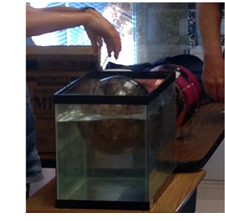 I talked with the science teacher at Lake Pointe Elementary where I work with the fifth graders in the science lab on a monthly basis. They were studying density. I like to use a demonstration of sinking and floating bowling balls to start the discussion. (If you don’t have a set of bowling balls, there are plenty of videos on YouTube including mine.) I needed something “hands-on” to reinforce the concept of density as mass / volume. That takes us to the second “A”, Adapt. I revised the use of the pennies in the plastic I talked with the science teacher at Lake Pointe Elementary where I work with the fifth graders in the science lab on a monthly basis. They were studying density. I like to use a demonstration of sinking and floating bowling balls to start the discussion. (If you don’t have a set of bowling balls, there are plenty of videos on YouTube including mine.) I needed something “hands-on” to reinforce the concept of density as mass / volume. That takes us to the second “A”, Adapt. I revised the use of the pennies in the plastic 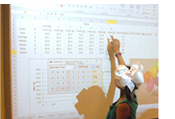 eggs. Each team of students was given a set of six colored eggs, pink, orange, yellow, green blue, and purple, each loaded with from three to 12 metal washers. The number of washers was consistent within the colors, e.g., every pink egg had three washers inside. The first step was for each team to measure the mass of the eggs and enter their measurements on the spreadsheet displayed on the SMART® Board in the front of the lab. The spreadsheet did the averages across all the teams. To fulfill this task the students learned how to use a triple beam balance. eggs. Each team of students was given a set of six colored eggs, pink, orange, yellow, green blue, and purple, each loaded with from three to 12 metal washers. The number of washers was consistent within the colors, e.g., every pink egg had three washers inside. The first step was for each team to measure the mass of the eggs and enter their measurements on the spreadsheet displayed on the SMART® Board in the front of the lab. The spreadsheet did the averages across all the teams. To fulfill this task the students learned how to use a triple beam balance.
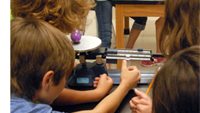 The next challenge was to determine the volume of a plastic egg. We had talked about and calculated the volume of a sphere in advance of putting the bowling balls in the water-filled aquarium. There were lots of ideas but we ended up just taking a beaker with 300ml of water and adding a purple egg which quickly sank to the The next challenge was to determine the volume of a plastic egg. We had talked about and calculated the volume of a sphere in advance of putting the bowling balls in the water-filled aquarium. There were lots of ideas but we ended up just taking a beaker with 300ml of water and adding a purple egg which quickly sank to the 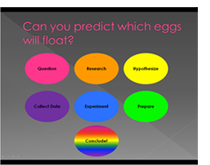 bottom and raised the level to 350ml; the students immediately recognized that the volume, via displacement, was 50ml. We added the volume to the spreadsheet and determined densities for each color of egg. bottom and raised the level to 350ml; the students immediately recognized that the volume, via displacement, was 50ml. We added the volume to the spreadsheet and determined densities for each color of egg.
Now it was time to put the data to use. We had a density for each of the eggs and we knew that the density of water was ~ 1g/cc; so, as a class, we “voted” if a specific color would float or sink. A student from each team brought up a different color egg to test their hypotheses. Success!
 The feedback from the students and teachers was very positive. We Accomplished our objective to convey an understanding of density and teach the students a few other skills during the process. To finish that third “A”, I need to write this up completely and submit it to Teachers TryScience, sharing this adapted activity across the STEM community. The feedback from the students and teachers was very positive. We Accomplished our objective to convey an understanding of density and teach the students a few other skills during the process. To finish that third “A”, I need to write this up completely and submit it to Teachers TryScience, sharing this adapted activity across the STEM community.
 I’m developing another adaptation that will be unveiled in November. A number of volunteers from Central Texas Discover Engineering join the Bullock Texas State History Museum educational staff for a monthly Science Thursday. The objective is to make connections between STEM and Texas history and culture (STxEM?) with quick hands-on activities for the students who are visiting on field trips. On October 25th, a new exhibit opens, La Belle: The Ship That Changed History. In addition to more than 100 artifacts from the LaBelle, experts will reassemble the ship timber by timber in the gallery. We have several activities to tie STEM to La Belle, including relating the buoyancy of plastic eggs to ships and their cargo. I’m developing another adaptation that will be unveiled in November. A number of volunteers from Central Texas Discover Engineering join the Bullock Texas State History Museum educational staff for a monthly Science Thursday. The objective is to make connections between STEM and Texas history and culture (STxEM?) with quick hands-on activities for the students who are visiting on field trips. On October 25th, a new exhibit opens, La Belle: The Ship That Changed History. In addition to more than 100 artifacts from the LaBelle, experts will reassemble the ship timber by timber in the gallery. We have several activities to tie STEM to La Belle, including relating the buoyancy of plastic eggs to ships and their cargo.
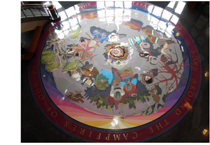 The museum is just a short walk, north of the state capitol. If you are attending SXSWedu in March take advantage of our great weather and visit the museum to check the progress on La Belle. The museum is just a short walk, north of the state capitol. If you are attending SXSWedu in March take advantage of our great weather and visit the museum to check the progress on La Belle.
(My wife, who is also my editor, deserves credit for locating dozens of plastic eggs in August. She used a multi-neighborhood message board to get neighbors to clean out their garages and attics. Thanks Leslie!)
I’ll be back again next month. In the meantime, you can follow me on Twitter or read my sometimes updated blog.
Rick McMaster retired from IBM as the STEM Advocate in December 2013, but continues his work in “STEM and more” through occasional tweets and blogging, continuing to serve on various technical boards, and chairing the Central Texas Discover Engineering outreach. You can reach him at drrhmcm@gmail.com, for continuing discussion. He believes that you can’t start too early to form the “T”.
Back to newsletter |